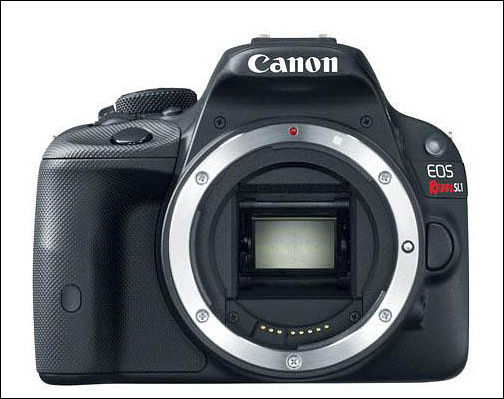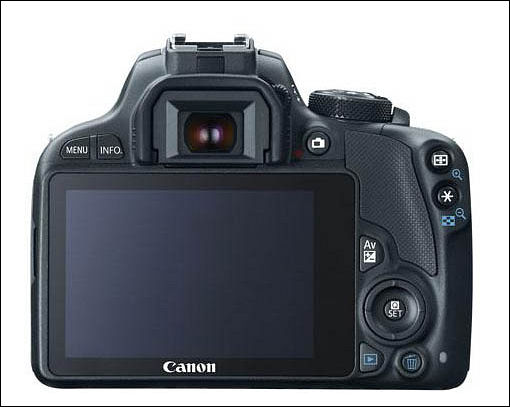
-
Small DSLR will be called EOS-b, accompanied by an 18-55m lens kit and will have $800 price tag.
Camera specs are identical to the T4i and EOS M. Digic 5 image processor, nine-point autofocus system, 3-inch 1.04K dot TFT-LCD touchscreen, four frames-per-second burst shooting, an ISO range from 100 to 12,800 and outdated HD video capture


Preliminary specifications:
- 18 million pixel sensor DIGIC5
- 1.04 million dot 3-inch LCD monitor
- 4 seconds of continuous shooting frames
- Full HD video
- Shutter speed - 30-1/4000
- Flash synchro - 1/200
- ISO range - 100-25600
- AF sensor 9-point, only central is cross
- Use SD / SDHC / SDXC
- Battery - LP-E12
- Weight (body only) - 370g, 407g with battery, memory card.
- EF -S 18-55mm IS STM kit
- $650 for body
Available at:
-
I am starting to get accustomed to this with Canon. It is the same camera with a different model number year after year.
How in the world is this going to be a better camera than an EPL-5 or even an OMD E-M5 which is about the same price now?
-
Canon really needs new sensor tech, but they can't compete with Sony on sensor war. Also they wouldn't wanna upset their much larger entry-level DSLR customers by releasing better mirrorless bodies.
I'm pessimistic about Canon's compact mirrorless. In the long run, it'll be Sony vs Samsung.
-
-
I didn't say m43 would die. Pentax is not a major player, but it's surviving :)
Currently major players are Canon and Nikon. But Sony and Samsung will be major players because they will lead the sensor war. Sensor is important. See the latest Leica M. The better sensor the better performance. Also Sony and Samsung are positioned to produce good optics, too.
Canon mirrorless... I will wait until Canon starts using Sony sensor. See how much Olympus has improved since adapting Sony sensors.
-
Right now most except Samsung and Canon are using Sony sensors in their products (sometimes not all). This is absolutely normal, as sensors become more and more complex and more and more costly to design and implement.
-
Increasingly sensor design is affecting lens design, too. You know that Samsung learned how to make lenses from Pentax :)
-
Well with the new Nikons, Toshiba is a player now too.
-
Well with the new Nikons, Toshiba is a player now too.
You do not know if sensor design is by Toshiba, it is just some monor work and manufacturing.
-
Eos-b. This is a joke?
Yes stonebat, there are now sensor that can adquire image with no proper optics, directly from sensor....so.. how i see it in the future is, better cameras for all. Canon is waiting patiently, he is not in any hurry, he is the Toyota of cameras.
-
- http://www.engadget.com/2013/03/21/canon-eos-rebel-sl1-t5i/
- http://www.theverge.com/2013/3/21/4129604/canon-launches-eos-rebel-sl1-the-worlds-smallest-and-lightest-dslr
- http://www.digitalcamerareview.com/default.asp?newsID=5260&news=canon+eos+rebel+SL1
- http://www.thephoblographer.com/2013/03/21/first-impressions-canon-rebel-sl1/
- http://www.imaging-resource.com/news/2013/03/21/canon-challenges-cscs-with-new-rebel-sl1-dslr-introduces-t5i-and-sx280-hs/
- http://www.dpreview.com/news/2013/03/21/Canon-unveils-EOS-100D-Rebel-SL1-worlds-smallest-and-lightest-APS-C-DSLR
- http://www.dpreview.com/news/2013/03/21/canon-eos-100d-rebel-sl1-hands-on-preview
-
It does appear from the Imaging Resource text that Canon SL1/100D has more advanced Hybrid CMOS AF II system from imaging sensor for Live View and Video with ~6 times larger AF area ("that uses approximately 80% of the width and height of the Live View display") than upgraded T5i/700D ("which takes up just 38% of the width and 26% of the height of the Live View display"). For still images both cameras use the conventional auto-focus sensor with 9 point AF. And why is just 1080p30 for Video?
-
Innovation at Canon's imaging department seems to be dead for a while. How many bodies did they release with the same sensor? 20?
@vitaliy_kiselve Isn't Fuji using non-Sony sensors in its latest models too? Or are they manufactured by Sony? They are the ones that are trying to do innovative new things, unlike Nikon/Canon. Sony/Olympus/Panasonic try but are still hammered by corporate protectionist thinking.
What I like about Fuji is that they have clear focus, they want to replace Leica at the high end.
-
Samples
-
Nice to see that all of the Moire and Aliasing is still there. Still don't know if the Auto Focus has improved at all though.
-
Looks like they tested the autofocus as well. It still hunts near the end of each refocus. Not anywhere near the GH3 standards but probably better than the last Canon efforts.
-
The relatively small size and light weight of the EOS 100D will make it a sought-after DSLR for travellers, bushwalkers and anyone who finds the current cameras have been too big and heavy. Its ability to accept most of Canon's lenses and accessories and merge seamlessly into an existing system make it a good choice as an extra body to complement a 'full frame' camera system.
Like the EOS 700D, the 100D has a well-designed user interface with a wide range of user-adjustable controls plus a well-thought-out suite of automated functions to help less experienced photographers achieve the high picture quality this little camera is capable of.
http://www.photoreview.com.au/reviews/dslr-cameras/entry-level/canon-eos-100d
-
The Canon EOS 100D is the smallest DSLR available with an optical viewfinder, and appears to be Canons answer to DSLR-style mirrorless cameras, being roughly the same size as the Micro Four Thirds Panasonic Lumix G6, as well as roughly the same price, although the G6 features a swivelling touch screen, quicker continuous shooting, and more advanced features built in (including Wi-Fi). In addition, Micro Four Thirds lenses are generally smaller than Canon EOS lenses. And herein lies the dilema with the Canon EOS 100D, while the camera body is much smaller, the lenses remain large and the new 18-55mm IS STM is in fact larger than the lens it replaces. Add to this the extremely competitive pricing of the latest mirrorless cameras, you have to wonder who will buy this new camera?
If you want a small camera with DSLR image quality, you can buy a much smaller mirrorless camera, for much less, or if you want a DSLR for more advanced features then the 600D and 700D are available with the extremely useful vari-angle screen. If the 100D was a replacement or update to the 1100D and had an entry level price point to match it, then the reduced number of features of the 100D would make sense, however at the moment the lack of some features, which most competitors now feature (stereo sound, panoramic, longer battery life), make it feel slightly limited at times.
http://www.ephotozine.com/article/canon-eos-100d-digital-slr-review-22047
Howdy, Stranger!
It looks like you're new here. If you want to get involved, click one of these buttons!
Categories
- Topics List23,964
- Blog5,723
- General and News1,342
- Hacks and Patches1,151
- ↳ Top Settings33
- ↳ Beginners254
- ↳ Archives402
- ↳ Hacks News and Development56
- Cameras2,361
- ↳ Panasonic990
- ↳ Canon118
- ↳ Sony154
- ↳ Nikon96
- ↳ Pentax and Samsung70
- ↳ Olympus and Fujifilm99
- ↳ Compacts and Camcorders299
- ↳ Smartphones for video97
- ↳ Pro Video Cameras191
- ↳ BlackMagic and other raw cameras121
- Skill1,961
- ↳ Business and distribution66
- ↳ Preparation, scripts and legal38
- ↳ Art149
- ↳ Import, Convert, Exporting291
- ↳ Editors191
- ↳ Effects and stunts115
- ↳ Color grading197
- ↳ Sound and Music280
- ↳ Lighting96
- ↳ Software and storage tips267
- Gear5,414
- ↳ Filters, Adapters, Matte boxes344
- ↳ Lenses1,579
- ↳ Follow focus and gears93
- ↳ Sound498
- ↳ Lighting gear314
- ↳ Camera movement230
- ↳ Gimbals and copters302
- ↳ Rigs and related stuff272
- ↳ Power solutions83
- ↳ Monitors and viewfinders339
- ↳ Tripods and fluid heads139
- ↳ Storage286
- ↳ Computers and studio gear560
- ↳ VR and 3D248
- Showcase1,859
- Marketplace2,834
- Offtopic1,319









